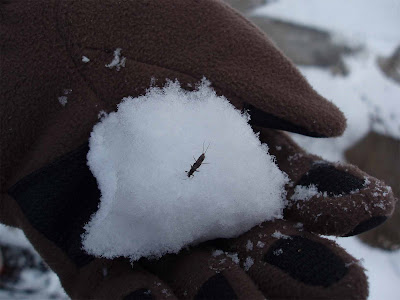 At Observatory Park, several of these two-tailed insects were seen crawling on the snow, just above an icy stream. These turned out to be quite fascinating insects known as winter stoneflies (a.k.a. snowflies)!
At Observatory Park, several of these two-tailed insects were seen crawling on the snow, just above an icy stream. These turned out to be quite fascinating insects known as winter stoneflies (a.k.a. snowflies)!Stonefly nymphs hide under stones in streams, and can only live in areas of very high water quality (way to go, Observatory Park!). They need cool, flowing, high-oxygen water to live since they have really dinky little gills.
The winter stonefly adults will emerge from the water, usually at the end of winter or early spring, and they are one of the few insects that are actually active on the snow. They may also display fascinating mating behavior by literally rocking out. In some species, the males will drum their butts against rocks in attempts to woo the ladies. The actual drumming is imperceptable to humans, but the stoneflies know what's up.
The photograph above shows an adult specimen, with a giant glove beneath it for scale. If you would like more images of this photogenic insect, you can check this BugGuide page.








